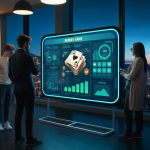Trade shows are a powerful platform for businesses to showcase their brand, connect with potential clients, and stay ahead of industry trends. But in a sea of booths, standing out is crucial. A custom trade show exhibit design allows you to highlight your unique value, create memorable experiences, and generate meaningful engagement. Whether you’re a seasoned exhibitor or a first-timer, smart design can make or break your success on the show floor.
Here are some essential tips for designing a custom trade show exhibit that grabs attention, reinforces your brand, and drives results.
1. Set Clear Goals Before You Start Designing
Before diving into design, define what you want to achieve. Are you aiming to:
- Generate leads?
- Increase brand awareness?
- Launch a new product?
- Build partnerships?
- Gather customer feedback?
Your goals will shape every aspect of the exhibit — from layout to graphics to interactivity. Having clear objectives ensures your design serves a purpose and delivers ROI.
Tip: Align your KPIs (Key Performance Indicators) with your trade show exhibit builders. For instance, if lead generation is the goal, create spaces for demos or one-on-one discussions.
2. Know Your Target Audience
Understand who you’re trying to attract. What are their preferences? What problems are they looking to solve? What motivates them?
Tailor your booth’s messaging, visuals, and interactive elements to appeal directly to your target demographic. Speak their language — visually and verbally.
Example: If you’re targeting tech-savvy millennials, go for clean, modern designs with interactive screens and social media integrations.
3. Prioritize Functionality Alongside Creativity
A stunning exhibit is worthless if it doesn’t function well. Your booth should enable:
- Easy navigation
- Comfortable conversations
- Product demonstrations
- Storage space for materials
Functionality includes choosing the right size, layout, lighting, and tech setup. Exploring innovative exhibition stand design ideas can lead to a well-designed booth that encourages visitors to stay longer and engage deeper.
Pro Tip: Use modular elements that can be reconfigured based on different show requirements.
4. Focus on Strong Brand Messaging
Your booth should immediately convey who you are and what you offer. Use consistent branding — logos, fonts, brand colors, and tone — throughout the space.
Incorporate your tagline or a powerful headline that communicates your value proposition in seconds. Trade show attendees walk fast — you have about 3-5 seconds to grab attention.
Key Areas for Branding:
- Backwalls and hanging signs
- Countertops and reception areas
- Digital screens and printed materials
- Staff uniforms
5. Use Strategic Lighting to Your Advantage
Lighting can dramatically enhance the appeal of your 30×30 trade show booth rental. It draws attention, sets the mood, and highlights key areas like products or signage.
Consider:
- Spotlights for product displays
- LED backlighting for logos
- Ambient lighting for creating a relaxing atmosphere
Don’t rely on default trade show lighting — invest in custom lighting that supports your booth’s story and function.
6. Leverage Interactive Technology
Today’s trade show attendees expect more than brochures. Engage them with interactive experiences such as:
- Touchscreen kiosks
- Augmented reality (AR) product demos
- Virtual reality (VR) experiences
- Interactive games or contests
- Live social media feeds
These elements increase dwell time, improve lead capture, and make your booth unforgettable.
Bonus Tip: Use digital lead capture systems to instantly collect visitor info and follow up faster.
7. Incorporate Product Displays Thoughtfully
If you’re showcasing products, display them in a way that complements your brand and encourages interaction. Avoid clutter—each product should have space to shine. A skilled trade show booth builder New York can help you design a layout that highlights your offerings while keeping the booth organized and engaging.
Use podiums, showcases, or wall mounts depending on the product type. Include descriptive signage or digital displays with specs, benefits, and use cases.
Example: For software, a demo station with guided walkthroughs and testimonials is more effective than printouts or posters.
8. Create a Comfortable Environment
Make your booth welcoming. A comfortable space invites visitors to stay and engage.
Include:
- Soft flooring (carpet tiles or vinyl wood panels)
- Lounge areas or seating arrangements
- Charging stations for devices
- Refreshments (if permitted)
Even small touches like potted plants, warm lighting, or aroma diffusers can elevate the experience.
9. Invest in High-Quality Graphics
Graphics make your first impression. Blurry images or poorly designed visuals can ruin credibility.
Keep your designs:
- High-resolution
- Bold and easy to read from a distance
- Minimalist — less is more
- Color-coordinated with your brand
Use large-scale visuals and compelling imagery to tell your story at a glance.
10. Train Your Booth Staff
Even the best-designed exhibit won’t perform well if your staff isn’t prepared. Train your team to:
- Greet visitors warmly
- Ask open-ended questions
- Qualify leads
- Provide product insights
- Maintain energy throughout the day
Ensure they know the layout and are familiar with any tech tools used in the booth.
Uniform Tip: Matching branded apparel reinforces professionalism and brand identity.
11. Utilize Vertical Space
Don’t forget to go vertical! Hanging signs, banners, and tall backdrops increase visibility from afar and help your booth stand out in a crowded hall.
This is especially important if your booth is surrounded by larger exhibits. Vertical elements draw the eye upward and give you more branding space.
12. Keep It Open and Inviting
Avoid blocking entry with tables or clutter. An open floor plan feels more approachable and encourages foot traffic.
Design your layout to flow naturally, guiding attendees from one area to another. Use visual cues like lighting, flooring patterns, or signage to lead movement.
Pro Tip: Corner booths or islands offer more exposure and flexibility.
13. Add a Wow Factor
To truly stand out, include an element that surprises or delights. This could be:
- A live demonstration
- A giveaway spinner wheel
- An art installation
- A 3D model or hologram
- A celebrity guest or influencer
This “wow factor” becomes a talking point and draws media and attendee attention.
14. Incorporate Sustainable Design Practices
Eco-friendly exhibits are not only good for the planet but also resonate well with environmentally-conscious audiences.
Use:
- Recycled or reusable materials
- LED lighting
- Digital brochures instead of printed ones
- Modular components to minimize waste
Let your audience know about your sustainable practices — it builds goodwill and brand trust.
15. Plan for Logistics and Installation
Design with installation, transport, and dismantling in mind. A great design should be practical, lightweight (when possible), and easy to assemble/disassemble.
Modular and portable elements save time and cost, especially if you exhibit at multiple shows. Consider working with a booth builder who offers turnkey solutions, including transportation, storage, and on-site setup.
16. Test Before the Big Day
Do a dry run or set up your booth before the actual event. This allows you to spot any issues in layout, tech integration, or lighting.
Test all electronics, signage placements, and engagement tools to ensure a seamless experience on show day.
17. Collect Feedback for Future Improvements
After the event, gather feedback from your team and booth visitors. What worked? What didn’t? Were your goals met?
Analyze metrics like:
- Number of qualified leads
- Engagement time per visitor
- Product interest areas
- Social media mentions
Use this data to improve your next exhibit.
Final Thoughts
Designing a custom trade show exhibit is both an art and a science. It requires creativity, strategic planning, and attention to detail. Your booth is an extension of your brand — make it a place people want to explore, engage with, and remember.
Whether you’re building in-house or working with a professional exhibit design company, following these tips can help you create a space that not only looks amazing but also drives real business results.
Ready to stand out at your next trade show? Start with purpose, design with clarity, and always keep your audience in mind.








